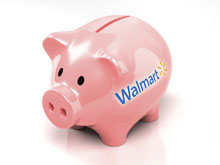Despite being pilloried by the public lately, a banker’s lot can’t be all that bad. At least, that’s what Wal-Mart executives must be thinking. Over the past year, they have unveiled one plan after another aimed at getting a bigger share of the U.S. retail banking market, which could be good news for some and bad news for others.
It started in August 2009 when Wal-Mart’s “Money Centers” began offering bill payment services. Then in March of this year, the Arkansas-based retailing giant announced that it will be increasing the number of Money Centers from 1,000 to 1,500 by the end of 2010. In May, the company introduced a new cash-back promotion for gas bought with Wal-Mart’s prepaid, reloadable debit cards, followed shortly afterward by the retailer’s purchase of a 1% stake in Green Dot, the prepaid card provider that Wal-Mart has been working with for the past three years. And beginning this summer, Wal-Mart’s U.S. customers can apply for small business loans at its membership-based Sam’s Club stores.
So what’s behind Wal-Mart’s latest push into banking? According to company news releases, it’s all about providing customers with greater convenience and lower-cost services. But retailing experts say it has a lot more to do with a focus on top-line growth. Financial services are an additional way to attract customers — and revenue — to the low-cost retailing behemoth’s 4,300 stores in the U.S. (It has another 4,000 stores in 15 other countries around the world, including Canada and Mexico.) “When you have 4,300 platforms to sell stuff, you are trying to sell whatever you can [under one roof],” says Nelson Lichtenstein, professor of history at the University of California at Santa Barbara (UCSB) and author of Retail Revolution: How Wal-Mart Created a Brave New World of Business. “All you have to do is carve out a little space and see what keeps customers coming back.”
The timing of Wal-Mart’s recent announcements — on the heels of the worst financial crisis in decades and Washington’s new banking reforms — is also not lost on experts. “I don’t think [Wal-Mart] does anything by accident,” says Erin Armendinger, managing director of Wharton’s Jay H. Baker Retailing Initiative. “If I was a financial institution, I would definitely worry, or at least take note, about whatever it does.”
Banking Battles
Many U.S. financial institutions have already been taking note of Wal-Mart. Ever since 1999, when Wal-Mart failed at its first of three attempts to acquire an industrial bank, many within the industry have made it clear that the retailer’s proposed banking foray is unwelcome. Banks showed their opposition in force in 2005 when Wal-Mart filed its first application with state regulators and the Federal Deposit Insurance Corporation (FDIC) to operate its own industrial bank. According to a report from CNN in 2005, the FDIC received more than 1,500 letters from banking officials and watchdog organizations protesting Wal-Mart’s banking charter application. Wal-Mart withdrew the application in 2007 after heavy lobbying against the move and a much-delayed approval process at the state and national levels.
Without a charter, Wal-Mart has had to limit the scope of its financial services to the basics, such as check cashing and money transfers rather than, say, deposit accounts, and it must do so by teaming up with authorized service providers. That includes MoneyGram for money transfers, Fiserv for bill payments, and GE Money Bank and Green Dot for Wal-Mart’s $3 prepaid debit cards, which are reloadable and don’t require a bank account or credit check. For small business loans, Sam’s Club is working with Superior Financial Group.
For Wal-Mart to build its financial services offerings further, the retailer will eventually want to acquire a charter, suggests Joseph R. Mason, professor of banking at Louisiana State University and a senior fellow at the Wharton Financial Institutions Center. He contends that Wal-Mart has been wrongfully denied a charter and will find a way to get one. “The steps the regulators have taken to [block] its charter application have been egregious,” he notes. “Wal-Mart is fighting a good fight, and with persistence it will get there. It will just take time.”
Yet according to Melissa Hill, a spokesperson for Wal-Mart Stores in the U.S., the company has “no plans to enter the banking industry here.” But it’s a different story outside the U.S. In Mexico, having launched Banco Walmart in 2007, the retailer recently announced plans to double its branch network throughout the country by adding 160 branches this year. In Canada, Wal-Mart received a banking license in May and immediately launched a Wal-Mart credit card, the bank’s first product.
Driving Customers
Wal-Mart executives have said little publicly about their financial services strategy in the U.S., but at the company’s annual meeting last November, Eduardo Castro-Wright, the retailer’s vice chairman and newly appointed head of global e-commerce, stated, “Our expectation is that [customers] will continue to drop the banks and buy [Wal-Mart’s prepaid] cards.”
Indeed, consumers’ attitudes toward banking are changing. An annual retail banking satisfaction survey in the U.S. by J. D. Power & Associates, a marketing-services company, found that the number of respondents saying they definitely will not switch banks in the next 12 months fell from 46% in 2007 to 34% today. Additionally, the survey results suggested that the public image of traditional banks is also declining, with “customers perceiving banks as being more profit-driven than customer-driven.”
Meanwhile, another recent survey highlights the extent to which retail banks are struggling to run their businesses, with revenue growth harder to come by as households reduce their indebtedness. According to a global poll of senior retail banking executives published this summer by management consultancy Accenture, more than half of the 46 respondents said customer profitability, as well as loyalty, continues to be far below pre-financial crisis levels. The majority of the executives also noted that customers are now both more price-sensitive and more willing to shop around for lower fees and better service.
The overall picture for the U.S. banking sector — retail and wholesale — looks grim and could lead to what some say is much-needed consolidation in a crowded market. In its latest annual “State of the Financial Services Industry” report, consultancy Oliver Wyman predicts that the total number of U.S. banks will fall from more than 7,000 today to around 4,300 by 2015 due to a wave of failures and “enforced mergers.”
All of this could work in Wal-Mart’s favor. Eric Clemons, a Wharton professor of operations and information management, says that Commerce Bank in Philadelphia, which was acquired by TD Bank in 2008, attracted thousands of customers by living up to its motto, “America’s Most Convenient Bank.” Not only did the bank increase convenience by expanding its network of branches from 115 to 409 in the five years before its acquisition, it also kept branches open on Saturdays and introduced longer weekday operating hours from 7 a.m. to 7 p.m. By the time Commerce was sold in 2008, assets under management had increased from $11 billion in 2003 to $51 billion.
Now, says Clemons, Wal-Mart wants to attract customers with similar convenience and service. “Wal-Mart keeps great hours [for its Money Centers],” he states. “This is likely to be the advantage.”
Another potential advantage is that Wal-Mart wants to attract a different consumer segment than traditional banks — customers who are “unbanked” (people without access to mainstream financial services) or “underbanked” (people not using mainstream financial services regularly). According to a 2009 study from the FDIC, one-quarter of all households in the U.S. have few, if any, bank accounts. The study also revealed that many of those households were comprised of low-income earners and minorities, with 71% of “unbanked” households making less than $30,000 a year and 24% being Hispanic.
“It’s remarkable how many people down there in the lower 20% to 30% [of the income ladder] don’t have a bank account, especially immigrants,” UCSB’s Lichtenstein notes. “If Wal-Mart can make it convenient, safe and doable for that slice of the population [to bank with them], it will have a market.” He also suggests that this segment is likely to pay slightly higher fees to use Wal-Mart’s services because of convenience and lack of trust in traditional banks to manage their money. “Many of these people live on a cash basis and are afraid of banks. But they are not afraid of Wal-Mart.”
The potential market size is enormous. Research from Wal-Mart in 2008 estimated that 28 million people in the U.S. are unbanked and 24 million are underbanked. The research also suggested that by charging less than the fees levied by alternative financial services providers, such as check-cashing centers, money-wiring stores and payday loan outlets, Wal-Mart could save customers between $3.25 billion and $6.5 billion a year.
Why the Worry
So if Wal-Mart insists that it’s not encroaching on retail banks’ traditional turf, why are bankers and regulators putting up blockades? The company certainly isn’t the first retailer to enter the financial services sector. Merchants have been offering credit ever since the 1800s, when general stores allowed customers to delay paying for purchases by putting them on an in-store account.
But retailers’ financial services really took off when Sears, Roebuck & Company set up Allstate Insurance in 1931, and in 1953 introduced its first credit card. In the early 1980s, Sears acquired the brokerage house Dean Witter Reynolds and launched its no-fee Discover credit card. But in the 1990s, Sears sold most of its finance-related holdings after shareholders complained that they were detracting from the retailer’s core business. Fast forward to today, however, and Sears is testing new financial centers — similar to Wal-Mart’s Money Centers — in a handful of its Kmart stores around Chicago.
While other retailers, such as Home Depot, have also unsuccessfully applied for bank charters in recent years, experts say Wal-Mart’s size is what worries banks the most. As the world’s largest retailer, the company’s 2009 group revenue of $405 billion was about 1.9% of U.S. GDP; in comparison, sales at Sears were $1 billion when the chain was pioneering retailer-based financial services in 1945, or about 0.4% of GDP. Combined revenue for Sears and Kmart at the beginning of 2010 was more than $44 billion. Today, there are twice as many Walmart stores than Sears and Kmart stores combined in the United States, and Walmart stores offer a wider selection of goods and services than any other retailer. “The bigness of Wal-Mart is a big subject,” Lichtenstein notes. “Wal-Mart is much larger than Sears in order of magnitude, and larger than any retailer today or 40 years ago in terms of its entire economic clout.”
As Stephen J. Hoch, a Wharton marketing professor and director of the Baker Retailing Initiative puts it, “Wal-Mart is all about scale. That is how costs could be reduced.” The company’s size combined with a bank charter could make Wal-Mart a force to be reckoned with for traditional banks, he adds. “Long term, I think Wal-Mart would like to get into the banking business not so much to make money on banking — which it could do by outsourcing and taking a cut of the profit — but as a means of creating greater consumer ‘lock-in’ by providing lower cost banking services.”
It’s a matter of debate whether the lack of a charter has hindered Wal-Mart’s need for scale. Wal-Mart does not break out the performance of individual units in its financial reports, but the retailer’s latest full-year announcement did state that its “financial services experienced strong double-digit income growth from check cashing, the $3 MoneyCard and the continued expansion of the Wal-Mart Money Center.”
The flurry of recent announcements notwithstanding, some observers suggest that financial services — with or without a banking charter — will not become a dominant part of Wal-Mart’s business. Wharton’s Armendinger says Wal-Mart has been careful not to stray too far from its core retail business, citing Sears’s failure when it did so, and that banking is merely one of several ancillary services — along with health care, for example — designed to keep customers coming back. “It’s just another way to get consumers in the door and make them more loyal to Wal-Mart,” she notes. “At the end of the day, [Wal-Mart] is hoping that its customers don’t have to leave the store for anything.”



